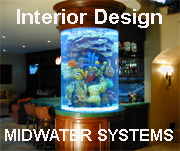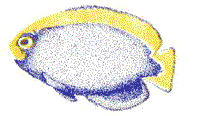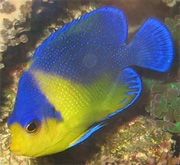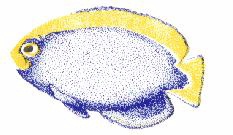|
So, you want to start a Reef Tank
?
Water Pumps
Now that you have selected your Tank, Stand, Canopy,
and Filter System its time to select the appropriate water pump to drive
your system. What type of pump(s) do you need and what should they do ?
There are a number of choices for pumps, the more
common are Magnetic and Centrifugal.
Most pumps utilize a core and armature. A Core
is wound with numerous windings of copper wire and once electricity, specifically
alternating current, is passed through the windings the rising and collapsing
of the electro-magnetic field ( EMF ) causes a positive - negative affect.
The armature, which rides on a shaft through the center of the core is
comprised partly of a magnetic cylinder. The magnetic cylinder has opposing
‘poles’, positive and negative, on either side of the cylinder which are
attracted and repelled by the magnetic field generated by the core windings.
The end result is that the armature turns as it is effected by the positive
- negative EMF created.
The more common variety of pumps using this principle
consist of Powerheads and Centrifugal pumps.
Powerheads are pumps that are generally submersed
within the water. Powerheads use a simple design, their core and windings
are encased within an epoxy filled cavity thus eliminating electrical current
leakage into the water. The armature, which is placed outside the case
but within the center of the core, consists of a cylindrical magnet attached
to a ‘body’ that spins on a shaft. At the opposite end of the magnet is
the Impeller, or propeller. As the impeller assembly spins on its shaft,
its propeller moves water in and out of its housing. These pumps normally
are used to drive Undergravel filters but can be used to push water from
the Wet - Dry filter back up to the tank, or for moving water within the
aquarium.
Centrifugal pumps use the same basic principle,
except that their core and armature are not intended to be submersed. These
pumps have an armature which has a series of magnets at one end of its
shaft. At the opposite end of this shaft is a large cup shaped magnet that
spins around the Impeller housing. Within the impeller housing is another
‘counter’ magnet that has its impeller blades, or propeller attached to
it. The reason for the more elaborate separation between the armature and
impeller is to separate the fluids being moved from the motor mechanism.
These pumps are more commonly used to push water back up to the aquarium
from the filter below the tank. Their advantage is that they either offer
greater strength or more water flow.
Both designs do generate some heat as the by-product
of their energy conversion. The degree of heat transfer is determined by
their motor and impeller design and their electrical consumption. What
determines the ‘strength' or water flow is the design of the motor and
impeller blades. Some pumps are intended to simply move water in a ‘no
resistance’ situation, these are refereed to as volume pumps.
Other pumps are designed to move water in a resistance
situation. Resistance can be in the form of friction from bends in the
plumbing or the distance the water has to travel. Engineers refer to resistance
in terms of Head Pressure, which is the distance from the pump, which is
drawing its water at one level, upwards or outwards to another level. These
pumps are refereed to as pressure pumps.
Now, what type of pump does your tank require
? First of all one needs to determine what it is that you want to accomplish.
Are you simply moving water from the reservoir below and using other pumps
to move water within the aquarium, or are you hoping to accomplish it all
with the use of one pump ? Is there a need to divert some of the water
flow into a protein skimmer, through canister filters, or to a chiller
?
In a nutshell you will need a pressure pump if
you are forcing water through something else, or to pump water up from
a lower level ( such as pumping water up from the sump to the tank ). If
this pump is using some of its flow to drive other pieces of equipment
then take that into consideration.
If you are using a pump to move water within the
aquarium to increase its internal water flow, or there is no significant
restrictions in its path, then a volume pump is the best choice.
Let me state at this point that the most common
reason for Algae and Nutrient problems are LACK OF WATER FLOW ! Good water
flow will help sweep debris and sediment out of pockets within the reef.
Additionally corals require a good flow of water to bring them food and
flush their waste products away.
I would like to offer some significant insight
at this point.... Water
pump manufactures ( Iwaki, Little Giant, Velocity, ect. ) have taken a hard line
and non caring approach to water pump warranty lately. They now require that you
or the dealer ship the water pump back to the factory so they can evaluate it.
This obviously is a BIG problem since your tank will not operate without the
pump and it will take at least three weeks or more. Make sure that the shop, company, or distributor
you are purchasing the pump from has the ability to provide you an immediate
replacement pump if needed. Being that the pump is equivalent to your systems
heart, if it were to break down how long can you go without replacing it
? My point is that if you need a replacement pump, whether warranty or
non-warranty, does your supplier have immediate replacements available
? There seems to be a trend with pump distributors ( let us take your money
but we refer the problems to someone else ) that they want you to send
the pump directly to the manufacture, who ( at their own pace ) will evaluate
the pump and deny, replace, or repair it.
You may wish to take a pro-active approach and have a
temporary or replacement pump available should your main water pump fail. |











